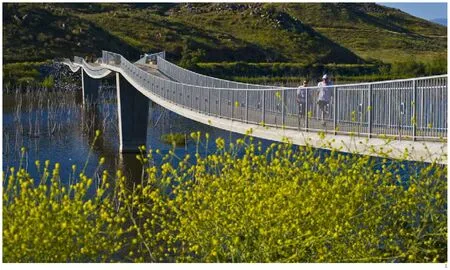霍奇斯湖桥,圣地亚哥,美国
2016-04-11工程设计林同棪工程顾问股份有限公司伊里斯特拉斯基工程顾问公司萨夫迪拉维内斯建筑事务所EngineersLinInternationalJiriStraskyConsultingEngineerSafdieRabinesArchitects
工程设计:林同棪工程顾问股份有限公司,伊里·斯特拉斯基工程顾问公司,萨夫迪·拉维内斯建筑事务所Engineers:T.Y.Lin International,Jiri Strasky Consulting Engineer,Safdie Rabines Architects
霍奇斯湖桥,圣地亚哥,美国
Lake Hodges Bridge,San Diego,USA,2009
工程设计:林同棪工程顾问股份有限公司,伊里·斯特拉斯基工程顾问公司,萨夫迪·拉维内斯建筑事务所Engineers:T.Y.Lin International,Jiri Strasky Consulting Engineer,Safdie Rabines Architects

1 实景/Bridge view
2 鸟瞰/Bird's-eye view
这座步行桥位于圣地亚哥郡的北部,是圣地亚哥河谷区开阔地公园的一景。该桥由3跨100.58m长的悬链连结而成,其中每一跨的中点下垂高度为1.41m。
霍奇斯湖悬链桥全长301.75m,由预制的悬链节段和现浇的桥鞍组成。悬链的两端固定在两岸桥台上,并与各个桥墩框接在一起。这种结构解决方案借鉴并发展了布拉格-特洛伊和雷丁的桥梁项目设计方式。
预制的悬链节段厚0.407m、长3.048m、宽4.266m,每段由两条边主梁和一块甲板组成,互相连接的结点处由隔板进行固定。在建造过程中,悬链节段首先被放置在承重缆绳上,后沿着缆绳滑动到预定位置。在浇筑完桥鞍和预制节段之间连接节点后,悬链被预拉伸的筋腱拉紧。承重缆绳系统由2×3条19-0.6"的缆绳组成,预应力筋腱由2×3 条27-0.6"的钢筋组成。缆绳和筋腱都藏在边梁上挖出的槽中。
每个桥鞍都有不同的厚度和宽度。厚度从0.407~0.910m不等,宽度从4.266~7.320m不等。每个桥墩上都设置了一个观景平台和座椅。桥鞍位于所有桥墩或桥台的正上方,是在所有预制节段建造完成后,被浇筑在预制节段表面承托着的模板中的。建造过程中,安装在钢鞍座上的铁氟龙板为承重缆绳提供支撑。
53×107N的水平拉力通过桥台被传送到两岸的土壤中:左岸通过直径2.7m的4个钻孔桩,右岸通过石锚。
设计经过了细致的静、动力分析实验,不仅能够承担普通的静压力,还可以耐受较大的地震荷载。分析表明,这座步行桥能够同时为行人提供舒适的步行体验,又在地震中具有一定弹性。为了证实该桥能在强风中保持平稳,加州的西风实验室为它进行了一次特殊的风力实验分析,将1:10的桥梁截面模型放入风洞,检测了桥面的空气动力学承重特性。(张裕翔 译)
项目信息/Credits and Data
总长/Total Length:302m
最大跨距/Maximum Span:100.5m宽度/Width:3.7m
摄影/Photos:T.Y.Lin International
The bridge is located in the northern part of San Diego County and it is a part of the San Dieguito River Valley Regional Open Space Park.The bridge is formed by a continuous stress ribbon of three equal spans of length of 100.58m.The sag at mid-spans is 1.41m.The stress ribbon of the total length of 301.75m is assembled of precast segments and cast-in-place saddles situated at all supports.The stress ribbon is fixed into the end abutments and it is frame connected with intermediate piers.The structural solution was developed from the pedestrian bridges built in Prague-Troja and in Redding.
The precast segments of the depth of 0.407m are 3.048m long and 4.266m wide.Each segment is formed by two edge girders and a deck slab.At joints the segments are strengthened by diaphragms.During the erection the segments were suspended on bearing cables and shifted along them to the design position.After casting of saddles and joints between segments,the stress ribbon was post-tensioned by prestressing tendons.The bearing cables are formed by 2×3 cables of 19-0.6" strands,the prestressing tendons are formed by 2×3 tendons of 27-0.6" strand.Both bearing cables and prestressing tendons are placed in the troughs situated at the edge girders.

The saddles have a variable depth and width.The depth varies from 0.407 to 0.910m,the width change from 4.266 to 7.320m.Above supports a viewing platforms with benches were created.The saddles were cast after erection of all segments in the formwork suspended on the already erected segments and supported by piers or abutments.During the erection the bearing cables were placed on Teflon plates situated on steel saddles.
The horizontal force as large as 53MN is transformed into the soil at the left abutment by four drilled shafts of a diameter of 2.70m,at the right abutment by rock anchors,
Very detailed static and dynamic analyses have been performed.The structure was checked not only for service load but also for significant seismic load.The analyses have proved that the bridge will be comfortable to users and will remain elastic under seismic loading.To verify that the bridge would be stable under heavy winds,a special wind analysis was performed by West Wind Labs,CA.Wind tunnel tests on a 1/10 scale model of the bridge section were performed to determine the aerodynamic load characteristics of the bridge deck.
评论
王向荣:霍奇斯湖桥如同一条悬浮在湖上的飘带,联通两岸,串联起区域的徒步路径。热爱自然的人一定会喜欢这座桥,它融合在湖光山色之中,形态轻盈舒展,飘荡的线型呼应着起伏的山峦。桥梁不仅是穿越湖面的便捷通道,也为步行者提供了观赏风景的全新视角。创新性的结构体系为桥梁带来独特的形态,作为一个艺术的介入,这座桥也强化了周围风景的价值。
张昕楠:融于自然
位于圣地亚哥河谷公园的霍奇湖步行桥,以其高超的结构和技术展示了在自然之中如何减少人工构筑物对景观的破坏。一方面,桥体的设计需要应对河面300m宽度带来的对桥体跨度的挑战,另一方面,又要尽量减少对自然河面的占据以及对景观的破坏。最终的设计仅以两个立于水中的支柱形成了3个跨度,并将预应力悬索隐藏在桥板之中,从而在保证结构稳定性的前提下,降低了桥板的厚度,并减弱了对自然景观的影响。
Comments
WANG Xiangrong:Spanning over the lake,Lake Hodges Bridge looks like a ribbon connecting both banks to string up the trails around this area.Nature-lovers would certainly like it.The Bridge merged in the landscape of lakes and mountains presents a lightsome and stretching appearance,with its fluttering linear form echoing to the rolling hills.It not only an easy access across the lake but also provides an unusual view of sight-seeing.Its creative body structure gives a unique form,while keeping surrounding views valuable as an art intervene.
ZHANG Xinnan:Harmony with Nature
Located in San Diego River Valley Park,the Lake Hodges pedestrian bridge shows how to reduce the destruction brought by artificial structures to the natural landscape with its superb structure and technology.On one hand,the design of the bridge needs to respond to the challenges of the bridge span brought by the 300-meter-wide river; on the other hand,it has to minimize occupation of the river and destruction of the natural landscape.The final design only uses two pillars in water to form a three-span bridge,and the prestressing tendons are hidden in the deck of the bridge,so that while the stability of the structure is guaranteed,the thickness of the deck is reduced and the impact on the natural landscape is weakened.
